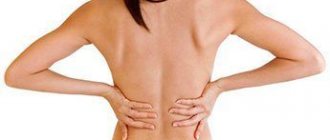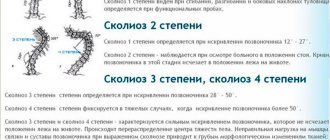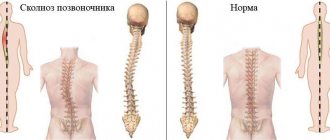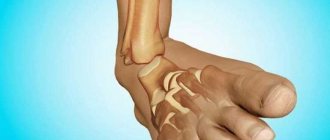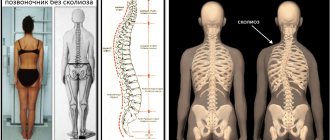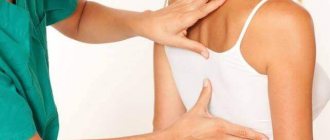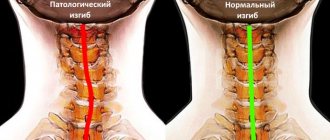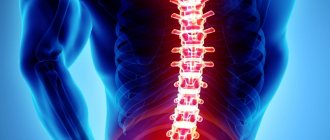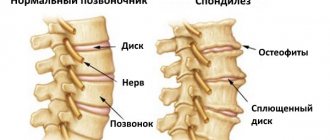Professor Glikman E. A.
In my practice, spinal scoliosis is one of the most common diseases. The number of high school children suffering from it is in some cases up to 50 percent or more. Maybe that’s why parents don’t have the necessary alertness to this insidious disease. I recently met a woman whom I accidentally counseled ten years ago. Her friend was being treated by me, and this then young girl came with her. I told her that she also had scoliosis and an oblique pelvis and recommended that she and her parents come for a consultation. She came with her mother, to whom I showed and explained everything. The mother said that everyone’s back was such that she couldn’t see anything special. And here is the result: the birth took place with a cesarean section, now her back hurts a lot, and she plans to come to me for treatment in the fall. Now I am treating another 14-year-old girl, who also has scoliosis of the spine and an oblique, twisted pelvis. This girl is successfully involved in gymnastics. Her mother said that the trainer herself promised to correct the spine with the help of physical education. The result is obvious - scoliosis is progressing, and time is working against the patient. About five years ago in Moscow I consulted a 42-year-old woman, Doctor of Pedagogical Sciences, very pretty and very sick. As a child she had scoliosis, which she did not treat. By the age of 42, he literally bent her, made her hunched over. She was worried about severe pain in the spine and right hip joint. Any movement was painful for her. Her passion for science literally from childhood diverted her attention from her own health. With difficulty I managed to alleviate her suffering at least a little.
It all starts with scoliosis!
A rib hump is not an independent disease, but a consequence of scoliosis, the most common pathology of the spine.
In the frontal projection (plane of the back), the spine should be absolutely straight. A person with correct posture, when standing with his back to the wall, simultaneously touches it with the extreme points of the back of his head, shoulder blades and buttocks.
A shift to the right or left is a sign of pathology. Its name is scoliosis, translated from Greek as “crooked”.
A characteristic sign of second degree scoliosis is a rib hump .
Causes of scoliosis
According to statistics, in 80% of cases scoliosis is diagnosed as idiopathic - that is, arising for reasons unknown to medicine.
Congenital scoliosis (5%) is a consequence of pathologies of intrauterine development.
The remaining 15% are acquired forms of scoliosis, the cause of which is
- Past illnesses that have caused weakening of the muscle corset (rickets).
- Intensive growth.
- Injuries.
- Lesions of the nerve roots of the spine.
- Constantly being in the wrong positions.
A hump has grown on my back - what to do?
A hump on the back is not so much aesthetically pleasing as it is a health hazard. It threatens with many problems, including loss of ability to work. This disease is more relevant among the population aged 45 years and older, when the muscular and skeletal system is already weakened. Preventing its development is much easier than getting rid of it.
Causes of hump appearance
There are two groups of reasons why the spine takes an anatomically incorrect curve:
- congenital;
- purchased.
A child is already born with a hump on his back due to intrauterine underdevelopment or a genetic reason.
What are the root causes of the appearance of a hump:
- Osteoporosis. When calcium is washed out of the body for a long time, the connective tissues of the vertebral bones become flexible and weak, and soon take on an abnormal shape.
- poor posture
. A weak muscle corset is not able to support the spine and incorrect posture appears. - Presence of tumors. Because of back pain, a person reflexively bends and thus his posture deteriorates.
- Back injuries. A spinal fracture can cause a hump.
- Long-term use of steroid drugs. These medications help flush calcium from the body.
- Menopause in women. Sex hormones are produced less, as a result of which subcutaneous fatty tissue decreases, and a characteristic ridge appears near the seventh vertebra.
Consequences of the appearance
- Physical. As a result of curvature of the spine, the functioning of the main organs and systems is disrupted. Due to a decrease in lung volume, breathing worsens, and the consequence of disturbances in the functioning of the heart is frequent headaches.
- Psychological. The person becomes closed and unsure of himself. Women are especially worried about a hump on their back. They unwittingly have to hide the pathology under special clothing. In general, people with such anomalies cannot realize themselves in a profession, have limitations in communication, and are deprived of a full life due to frequent pain.
Methods of effective treatment
Straightening the hump is possible only with the right approach and precise execution of all the instructions of a specialist doctor.
- Drug therapy. If a patient with kyphosis suffers from severe pain, then he is prescribed non-steroidal anti-inflammatory drugs. To strengthen bones and reduce neurological disorders, vitamin and mineral complexes are prescribed.
- Taping. This is a new technique in the treatment of kyphosis. Special elastic strips with varying degrees of stretchability are attached to the back to the skin, with the help of which the muscles are stimulated. Taping does not so much strengthen as it relieves muscle tension, reduces pain and corrects posture.
- Massage .
One of the most effective procedures for treating kyphosis.
Improves local blood circulation, supply of oxygen and nutrients to the discs. Therapeutic massage can relieve spasms. Every year, 2-3 courses of massage are required, consisting of 8-12 procedures. The duration of physical therapy is individual for each patient. Therapeutic back massage
can only be entrusted to a specialist with a medical education. - Orthopedic correction. For those who cannot keep their back straight on their own and intuitively begin to slouch, doctors may recommend wearing a special corset. Most orthopedic products do not need to be worn constantly, no more than 3-4 hours a day, otherwise the muscle tissue may atrophy.
- Physiotherapy. Using ultrasound and magnetic therapy, electrophoresis, and heat compresses, you can increase metabolic processes and blood circulation in the affected area. They will help reduce spinal pain, inflammation and swelling.
- Physiotherapy. The physical therapy doctor prescribes special exercises to strengthen the upper back. You can conduct such classes yourself at home. With systematic training, it is possible to strengthen the thoracic region and gradually straighten the hump. While performing exercises, you need to monitor your well-being. If you experience pain, severe weakness, or feel dizzy, you should stop exercising and consult your doctor.
- Swimming. It is an effective method to strengthen the muscle corset. By exercising regularly, it is possible to correct spinal pathology, relieve tension and get rid of pain. It is recommended to take classes under the supervision of a trainer, 2-3 times a week.
- Surgical intervention. It is impossible to do without it if the hump cannot be straightened using the indicated methods, or if it continues to grow.
Disease Prevention
If there is a risk of a hump appearing, then following some simple rules will prevent its formation:
- watch your posture, walk with a straight back, without slouching;
- more physical activity, but do not overstrain the spinal muscles;
- swim in the pool at least once a week;
- It is recommended to sleep on a moderately hard or orthopedic mattress and a low or orthopedic pillow;
- eat foods containing vitamins and calcium, and if they are deficient, use vitamin-mineral complexes;
- monitor the condition of the thyroid gland - hormonal disruptions are possible, especially in women during menopause;
- do not smoke, as nicotine promotes leaching of calcium from the body.
Make time for sports. Everyone, at any age and state of health, can decide on a useful activity for themselves - be it fitness, race walking, yoga, swimming, cycling, running, etc.
Physical activity helps strengthen the muscular corset, which keeps the spine in the correct position.
Healthy and physically active people are less prone to spinal diseases. Author: K.M.N., Academician of the Russian Academy of Medical Sciences M.A. Bobyr
Stages of scoliosis
A feature of the development of scoliosis in children is its rapid progression against the background of the growth process, therefore, the most “dangerous” age periods are 5-8 and 10-12 years.
Scoliosis occurs more often in girls than in boys.
Prognosis and treatment depend on the depth of the lesion and the degree of deformation of the ribs and spinal column.
With first-degree scoliosis, the vertical deviation is only 5-10 degrees and is visually almost imperceptible.
The body itself tries to correct the defect by adjusting its gait. In the supine position, the curvature is restored. There is no discomfort, so the first stage is easy to skip.
In fact, deformations are already occurring in other parts of the body:
The bend in the area of the shoulder blades leads to the fact that one shoulder rises higher than the other, and the arch in the lumbar area causes a distortion of the pelvic bones, as a result of which one leg gradually becomes shorter than the other.
With second-degree scoliosis, the defects described above become visually clearly visible. X-ray photographs show a deviation of the spine from the central axis of 11-25 degrees.
On the outside of the curve of the spinal column, the ribs diverge, and on the inside, they compress. In addition, they begin to deviate in the horizontal plane due to torsion (twisting) of the vertebrae.
Diagnostics
An orthopedist deals with the diagnosis and treatment of scoliosis. The doctor conducts a physical examination, which allows you to identify the presence of scoliosis based on its symptoms.
The main tool in diagnosing scoliosis is radiography. If the development of pathology is suspected, examinations are prescribed 1-2 times a year. The first image allows you to determine the presence of scoliosis, and all subsequent images allow you to assess the rate of development of the deformity, its shape, examine the condition of the vertebrae, their torsion or, conversely, rotation.
Since regular observation is indicated during the period of active growth, and frequent exposure to X-rays is harmful, non-radiation research methods have been developed. These include ultrasound, computer-optical diagnostics, and Bunnel scoliometry.
In some cases, an MRI of the spine is prescribed to determine the cause of scoliosis.
When does a rib hump appear?
As a result of three-dimensional deformation, the back in the area of the shoulder blades begins to protrude back, a rib hump appears, and above it a muscle compaction (ridge). With grade 2 scoliosis, the hump is clearly visible when bending forward, but in a standing position it is less noticeable.
Medicine is also aware of rare cases when the hump appears not on the back, but in the front.
Whether the hump will progress or stop growing directly depends on the further development of scoliosis.
Types and symptoms of scoliosis.
- Cervical scoliosis:
it is characterized by pain in the shoulder or interscapular space, headaches and dizziness. Increased pain occurs when tilting or keeping the head in one position for a long time; - Thoracic scoliosis:
manifested by difficulty breathing, disruption of the heart and lungs. With scoliosis of the thoracic region, a rib hump is formed, and back pain occurs; - Lumbar scoliosis:
the most common type of pathology, since it is this part of the spine that bears the greatest load. The disease is characterized by debilitating pain in the lumbar region; - Cervicothoracic scoliosis:
characterized by intense pain in the muscles, head, and bone structures. Pain increases when changing body position, taking a deep breath, or coughing. An additional symptom is numbness in the fingers; - Lumbar-thoracic scoliosis;
- Lumbosacral scoliosis.
Conservative treatment of scoliosis in children
Scoliosis in children at stages 1 and 2 can be corrected using conservative methods:
- During treatment, the causes (if they can be established) of its occurrence are eliminated.
- A set of procedures is prescribed to strengthen the muscle corset and restore body symmetry: therapeutic exercises, swimming, reflexology and physiotherapy, massage, wearing a corset.
The figure of a growing child is constantly changing, sometimes nature itself comes to the rescue and non-surgical methods bring results.
But it also happens the other way around, when it progresses rapidly...
Scoliosis of the third and fourth degrees is characterized by increased symptoms, the scoliotic angle increases to 40-80 degrees, 2 or 3 scoliotic arcs are observed, the hump grows and becomes clearly visible, the figure is ugly skewed, the gait is a rocking gait reminiscent of a duck step.
In addition to visual changes, pain .
Deformed ribs put pressure on the heart and lungs, which can cause respiratory and cardiovascular failure .
They say there is no cure for this
There is a deal of truth in it. Most cases of scoliosis are associated with the so-called idiopathic type, the cause of which is unknown to medicine. Idiopathic scoliosis has a progressive course, which often cannot be stopped at an acceptable level with conservative methods. Then the patient is scheduled for surgery. There is only a limited group of patients with idiopathic scoliosis who can be helped: these are children and adolescents with incomplete bone growth and the 2nd or initial 3rd degree of the disease. Complex therapy in this case can stop the progressive course of the disease and correct spinal deformity.
Surgical treatment of scoliosis in children – when is surgery needed?
In case of scoliosis of 3rd degree, as a rule, and in case of 4th degree, surgery is mandatory.
The operation is aimed at restoring the verticality of the spine while maintaining its overall mobility.
an implant is attached to the deformed area - a special metal structure that resembles a belt with screws. The screws allow each vertebra to be fixed in the desired position and allow the surgeon to align the spinal column, orient it in the desired direction, and secure the result.
If the child is still growing, dynamic structures are used that can lengthen along with the growing spine.
As the curvature disappears, the scoliosis hump also goes away. This doesn't happen right away.
For cosmetic purposes, after six months, it is possible to perform an operation to resection the scoliosis hump .
Treatment
Depending on the causes and stage of scoliosis, conservative or surgical treatment is prescribed.
Conservative treatment for scoliosis aims to eliminate the root cause. For example, if scoliosis appears as a result of injury or different lengths of the limbs, then the difference can be easily corrected with properly selected orthopedic shoes. The same cannot be done with scoliosis of a neurogenic nature - surgery is necessary here.
For idiopathic scoliosis, when the cause is not established, special gymnastics and wearing an orthopedic corset are prescribed. Progressive deformity requires inpatient treatment in specialized clinics.
